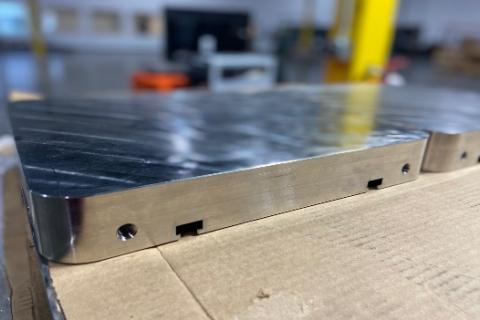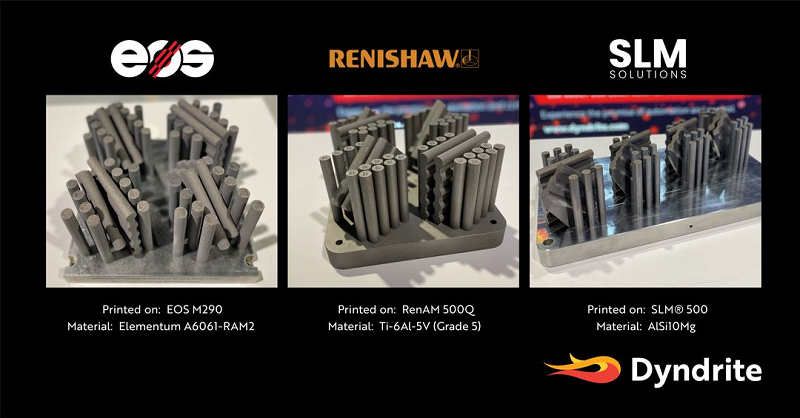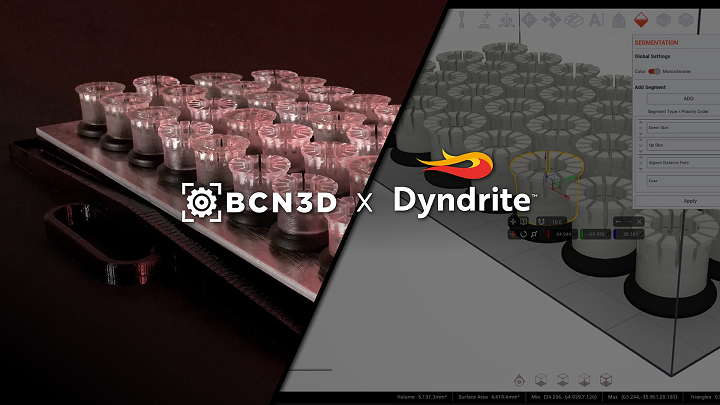Like so many other 3D printing companies, Dyndrite attended the recent RAPID + TCT, North America’s premier annual additive manufacturing trade show. The Seattle-based AM software company, which developed its Accelerated Computation Engine (ACE) and Application Development Kit (ADK) to help customers create digital manufacturing software and hardware, showcased a group of parametrically-created Laser Powder Bed Fusion (LPBF) builds representing several metal 3D printer providers, including Aconity3D, EOS, Renishaw, and SLM Solutions, for which it provides native file integration. Dyndrite’s LPBF materials and process software can help control surface roughness, tailor print parameters for complex geometry, enable methods for developing angle-based print support requirements, and more.
Additionally, Dyndrite made several announcements before and during the event.
Impossible Objects
First, Impossible Objects is using Dyndrite’s ADK to power its high-speed composite-based additive manufacturing process. CBAM 25, which uses roll-fed inkjet technology, is said to be 15 times faster than its competitor processes, with a continuous printing rate of 25 feet per minute, or almost 11,000 cm^3/hr of parts printed per hour.
“Impossible Objects pioneered the CBAM process, bringing an unprecedented level of part durability to additive manufacturing. Our new CBAM 25 process now operates fifteen times faster than the nearest competitor, while delivering the superior material properties required for industrial-grade end-use parts. For a speed comparison, this is the difference between the fastest human and a Formula 1 car in covering a mile,” said Robert Swartz, Founder and Chairman of the Board at Impossible Objects. “This achievement is not only a great feat for Impossible Objects, but for our industry – it moves 3D printing into a new category of volume manufacturing.”
CBAM 25 is durable and simple to maintain, operates at room temperature, and is easy to operate, and the machines will be available early next year. The proprietary Rules-based Automated Masking Packing and Slicing (ON-RAMP) software by Impossible Objects is powered by Dyndrite, and drives the CBAM process by integrating Dyndrite’s GPU-accelerated, Python-based ACE. The software offers a programmable, automated CAD-to-print workflow with a much faster build time and traceable, repeatable parts, as well as an easy-to-use GUI. The Dyndrite-driven solution also achieves a 90% reduction in manual labor, 20% improved build block use, faster processing of native CAD 3D data, customizable workflows, and more.
 The ON-RAMP app was built and branded using the Dyndrite ADK. The app development process has been simplified, and allows Impossible Objects to iterate on their software quickly.
The ON-RAMP app was built and branded using the Dyndrite ADK. The app development process has been simplified, and allows Impossible Objects to iterate on their software quickly.BCN3D
The next Dyndrite announcement is that the first generation of BCN3D‘s patented Viscous Lithography Manufacturing (VLM) technology will be powered by its software. The production-oriented process uses high viscosity resins to print high-performance parts for less money, at a higher speed. VLM enables formulations with more modifiers and ingredients because it can process resins that are 50 times more viscous than the industry standard, which then opens up new mechanical and thermal properties. More than 500 companies have registered as early adopters of the technology through BCN3D’s VLM Technology Adoption Program (TAP).
BCN3D has learned a lot about multi-property, multimaterial, and water-soluble applications from engineers in its TAP network who work in industries like dental, automotive, footwear, manufacturing, and 3D printing services. When looking to control its VLM units, the company researched top software providers and decided that Dyndrite’s ADK was the ideal solution. Using this GPU-powered production software is very important for BCN3D to be able to address software challenges that occur during automated 3D printing, and VLM users should be able to enjoy increased automation and productivity for their high-end polymer parts.
“We’ve been following the VLM technology since the initial showcase, and have been excited about the possibilities,” said Dyndrite’s Founder and CEO Harshil Goel. “We created the Dyndrite ADK to help machine builders unlock the power of their process and rapidly bring new manufacturing solutions to market. We are excited to see how the VLM technology will be productized with an eye towards manufacturing productivity and multi-material applications. BCN3D is about to generate some very interesting IP and we are excited to be the maths engine that plays a part in unlocking it.”
BCN3D will start sending the initial VLM systems to designated TAP participants this quarter.
AMFG
MES and workflow software provider AMFG is also integrating with Dyndrite, and the two announced AMFG powered by Dyndrite—a combined solution that will help achieve an easy one-stop shop for automated metal 3D printing. 3D print preparation, or additive CAM, is still a lengthy manual process and hinders a fully autonomous manufacturing workflow, especially in cases where machines from different vendors are used, or orders from multiple customers have to be in the same build. We still don’t have standardization of file formats, which adds time to print jobs, and there’s a skills shortage to contend with as well. Plus, costs rack up when you have to pay for multiple legacy software licenses and modules to manually prepare the files.
The integrated AMFG powered by Dyndrite solution streamlines and automates the whole metal LPBF production process, which makes everything more efficient and less expensive. The combined solution makes it possible for service bureaus and users to easily receive and collate orders from multiple customers, and Dyndrite’s GPU-accelerated CAM engine allows the parts to be nested, supported, and labeled, and for toolpaths to be generated for compatible machines, such as the aforementioned SLM Solutions, EOS, Renishaw, and Aconity3D.
The resulting production build data goes into AMFG’s own MES, which provides real-time status updates and analytics, and the data also goes into the QMS, to ensure quality. This integrated solution helps reduce the time to ship as well, and overall facilitates a much faster time to market.
“We are entering a new era of manufacturing. One driven by data and automation. By adopting Dyndrite we enable data automation down to the toolpath, unlocking the full potential of each machine, while growing efficiency and reducing the potential for human errors,” said AMFG’s Founder and CEO Keyvan Karimi. “Dyndrite’s cutting-edge technology is enabling our LPBF customers to produce complex parts with unprecedented precision, speed, and reliability, giving our industry the boost it needs to compete with traditional manufacturing techniques.”
AMFG powered by Dyndrite will be available in Q3 2023.
UPM Additive Solutions
Finally, Dyndrite and UPM Additive Solutions, a top supplier of metal build plates, have entered into a joint agreement to bring data intelligence to build plates by creating “smart” plates for the metal AM industry.
“For the AM production industry to scale we must develop new tools to enable it,” stated Goel. “By working with UPM and leveraging the power of machine data we can accelerate learning, improve predictability and grow. Through insights of the data we allow users to make less risky decisions on their build plates to assure success.”
 Image courtesy of UPM Additive Solutions
Image courtesy of UPM Additive SolutionsBuild plates are the foundation of prints, but many users don’t record important data that can inform them about the history and lifecycle of their plates. For LPBF users, this can lead to internal fatigue, powder leveling issues, and warping plates, all of which can result in print failures, i.e. lost time and money. Together, UPM Additive Solutions and Dyndrite will work to capture and provide this critical data in order to ensure a reliable supply chain.
“UPM is excited to partner with Dyndrite and its metal users to unlock the keys to build plate life. Through data, we can put knowledge in the hands of the user to raise throughput and reduce failures,” explained Chris Prue, Applications Development Manager, UPM Additive Solutions. “Build plate usage data helps customers understand and manage their usage and demand for plates to keep costs low while keeping inventory available to reduce downtime. Through smart build plates and a reliable supply chain, we can collectively mature and grow the industry.”
Dyndrite will focus on the data aspect of this collaboration, while UPM Additive Solutions offers subscription services that can track build plates from manufacturers through customers and all the way to its refinishing. Each one is serialized, and maintains quality inspection data that’s easy to access, so Smart Build Plate customers can view the associated build data, including heat treatment, stress relief, and laser powder. The Smart Build Plate service should be available in Q3 of this year, and will support all major metal 3D printer OEMs.
Images courtesy of Dyndrite, unless otherwise noted.
Subscribe to Our Email Newsletter
Stay up-to-date on all the latest news from the 3D printing industry and receive information and offers from third party vendors.
Print Services
Upload your 3D Models and get them printed quickly and efficiently.
You May Also Like
Havaianas Collaborates with Zellerfeld to Launch 3D Printed Flip-Flops
The shoe of the summer is undoubtedly the flip-flop. Easy on, easy off, your feet won’t get sweaty because there’s not much material, and they’re available in a veritable rainbow...
UCLA Researchers Develop 3D Printed Pen that May Help Detect Parkinson’s Disease
Diagnosing Parkinson’s disease is difficult. Often, early symptoms of the progressive neurological condition may be overlooked, or mistaken for signs of aging. Early diagnosis can help save lives and improve...
Printing Money Episode 30: Q1 2025 Public 3D Printing Earnings Review with Troy Jensen, Cantor Fitzgerald
Printing Money is back with Episode 30, and it’s that quarterly time, so we are happy and thankful to welcome back Troy Jensen (Managing Director, Cantor Fitzgerald) to review the...
Heating Up: 3D Systems’ Scott Green Discusses 3D Printing’s Potential in the Data Center Industry
The relentless rise of NVIDIA, the steadily increasing pledges of major private and public investments in national infrastructure projects around the world, and the general cultural obsession with AI have...



































